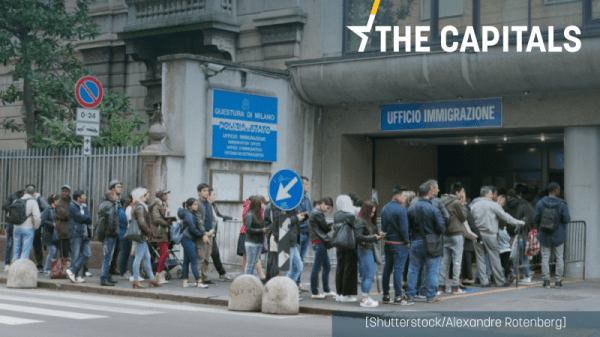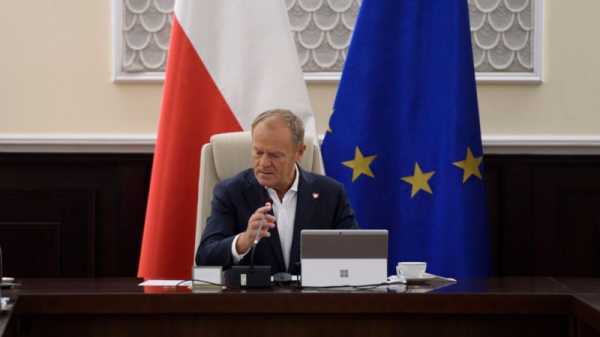
*Amends the story to clarify that the Netherlands did not veto Romania’s Schengen bid
As the migration crisis continues to simmer across Europe, EU leaders at a special summit on 9 February are expected to focus on increasing migrant returns rather than seeking a comprehensive solution.
EU officials concede that bottlenecks exist at every step of the migration process. Limited burden-sharing and overstretched national immigration authorities that cannot prevent migrants from filing asylum applications in multiple states have resulted in a system that is in a near-permanent crisis.
Applying the pressure
Austria and the Netherlands have been the main drivers of this week’s European Council summit, with Austria recently vetoing the accession of Bulgaria and Romania to the passport-free Schengen area saying they were not ready to adequately protect the European borders.
“We have now put this issue back at the centre of the European discussion,” Austrian Chancellor Karl Nehammer said after the last meeting of EU leaders in December.
According to a European Commission report leaked to the newspaper die Welt, Austria has received the fourth most migrants in the EU and the most asylum seekers per capita. According to the Austrian Interior Ministry, 40% of these migrants passed through Bulgaria.
“We want to support Bulgaria in protecting the border even more efficiently. Bulgaria cannot manage even more controls on its own,” Nehammer told Bulgaria during a state visit in January. According to the Austrian chancellor, Bulgaria should receive at least €2 billion in assistance to build – among other things – a wall at its border with Turkey.
Dutch Prime Minister Mark Rutte, for his part, warned that “we have to go back to the Dublin rules” or Schengen “will not survive”.
The EU Commissioner for Home Affairs, Ylva Johansson, has said she wants to find a “pragmatic” solution on border fences, which Nehammer last week described as “a step in the right direction that shows our push for concrete action was important”.
The row over the expansion of Schengen is indicative of a set of national immigration services that, in most cases, are in severe difficulty.
Slow decision-making, growing backlogs
Those difficulties start with slow decision-making processes.
According to a report by the German federal agency on migration and refugees, the asylum procedure takes an average of 7.6 months from application to decision. However, that increases to a 26-month average if the claimant appeals the decision in court.
Similarly, Germany’s Federal Office for Immigration and Asylum (BFA) and Czechia’s Interior Ministry are required to take a decision within six months of the date of the asylum application. At the end of last October, there were 110,385 such open cases.
There are similar patterns elsewhere, though improvements have been recorded in France, where the average time taken to process an asylum application in 2022 was 5.2 months, down significantly from 2020 and 2021 when it was over 8.5 months.
That has led to a slight drop in the number of pending applications in France to around 47,000, according to the Office Français de Protection des Réfugiés et Apatrides.
According to data from the Interior Ministry in Vienna, there were 44,935 unresolved cases in December 2022 in Austria.
At the same time, Czechia reported only 768 but still complained of being thinly stretched.
“The authority is currently at the edge of its capacity. Any fluctuation in the number of applications submitted would make it impossible to implement the procedure within the deadlines,” Hana Malá from the Interior Ministry told EURACTIV Czech Republic.
In Italy, 72,423 asylum applications were submitted between 1 August 2021 and 31 July 2022, almost 32,000 more than in the previous year. Some 57,558 applications were examined.
In Croatia, which joined Schengen just this January, the Centre for Peace Studies (CMS), a Zagreb-based NGO, reckons that asylum requests take “between one and two years” based on cases they have been involved in.
Interior Minister Davor Božinović said last November that 36,000 migrants had arrived in Croatia through the Balkan route in 2022, a 145% increase from 2021. The majority are formally asked to leave the EU voluntarily within seven days.
Spain has been struggling to manage asylum applications since the Syrian refugee crisis in 2015, but the situation worsened four years ago when the number of applications began to grow exponentially.
Once the application has been admitted for processing, Spanish law requires that a decision must be taken within six months. However, the process often takes up to a year, say Spanish NGOs.
Around 94,500 applications are still pending, according to the Spanish Asylum and Refugee Office.
In Greece, meanwhile, It can take between 6 months and 3 years to complete an asylum application process.
If the authorities determine that the applicant came from Turkey, they have to go through an initial interview to prove they are not in danger in Turkey, then a second one to receive or be denied asylum.
In Finland, the average processing time is 229 days, and the Immigration Service has a backlog of 3,136 outstanding cases, or 4,814 if Ukrainian asylum seekers are included. However, Ukrainians are entitled to temporary protection and their asylum cases are not processed in the same way.
Belgium’s Office of the Commissioner General for Refugees and Stateless Persons (CGRA) also aims to have a decision within six months but the pandemic created a large backlog, in large part because interviews with applicants had to be suspended.
Post-pandemic, meanwhile, migrant numbers have increased. In 2022, nearly 37,000 applications for asylum were registered in Belgium, an increase of 40% on 2021, with Afghanistan, Syria, Palestine, Burundi and Eritrea the main countries of origin.
Slow pace of returns
Slow decision-making is matched by slow processes in returning failed asylum seekers to their country of origin or the EU state in which they originally arrived.
According to data from the European Court of Auditors (ECA), a total of 19,745 forced returns and 2,183 assisted returns were carried out between 2018 and 2021 out of more than 136,000 migrants who landed, 14.5% and 1.6% of the total, respectively.
However, several governments are now trying to increase their focus on enforcing repatriation.
That includes the centre-left government of Chancellor Olaf Scholtz in Berlin. In the first half of 2022, Germany repatriated 6,198 migrants, mainly to North Macedonia, Albania, and Georgia.
For its part, Belgium’s Fedasil’s reported that 2,673 were voluntarily returned to their home country in 2022. Fedasil coordinates and pays for the return, and the International Organisation for Migration (IOM) organises the return by plane or by bus.
In 2021, out of 3,420 people repatriated by Italy, 1,945 were Tunisian nationals. However, the details of the agreements between Italy and Tunisia on migration have never been fully made public.
According to the Luxembourg-based European Court of Auditors (ECA), the lack of cooperation with migrants’ states of origin is the main cause of the poor results on returns at the European level.
A 2019 report by ECA highlighted a series of shortcomings in Italy, including the absence of a valid return management system, the difficulties in locating migrants to be repatriated, the insufficient capacity of the Centres of Permanence for Return (CPR), and limited cooperation with the migrants’ countries of origin.
Croatia also has an agreement on relocation of migrants housed in camps in Greece and Italy, and several hundred have been relocated here as part of the EU solidarity mechanism.
However, since they are free to travel while their applications are being processed, it is estimated that around 75-90% of asylum seekers move on to other countries before the decision is even made.
For example, 2020 saw close to 2,000 formal applications, with nearly 1,700 cancelled because the applicant left the country before the decision was handed down. Only 42 – 2% of the total – were eventually granted. The main countries of origin of applicants are Afghanistan, Iraq, Iran, Turkey, and Syria.
Third country deals
An already complex system of returns is complicated by a web of bilateral readmission agreements between EU and third countries that are in addition to common EU readmission deals.
For example, Croatia has bilateral readmission agreements with neighbouring Bosnia- Herzegovina and Serbia, as well as with some third countries, including Pakistan.
The Czech Republic currently has 17 bilateral agreements with the likes of Germany, Poland and Slovakia and with non-EU countries, including Armenia, Kosovo, Moldova, Mongolia, and Vietnam.
Germany has bilateral repatriation agreements with 16 non-EU countries, including Norway and Switzerland, while Finland has such agreements with Bulgaria, Estonia, Kosovo, Latvia, Lithuania, Romania and Switzerland, and a memorandum of understanding on voluntary return with Somaliland.
Austria has 22 bilateral repatriation agreements, according to a parliament inquiry in 2021, three of which are with non-EU countries: Kosovo, Nigeria, and Tunisia.
Buckling under the strain
Immigration authorities across the EU are buckling under the weight of rising numbers of applications, existing backlogs, and even poor training.
In Croatia, Sara Kekus from CMS told EURACTIV that “there are indicators that immigration authorities lack adequate training and understanding of human rights of refugees and other migrants, especially the principle of non-refoulement, the psycho-social implications of traumas survived, as well as of the situation in their countries of origin.”
“Moreover, in our experience, immigration authorities employ staff who rarely speak any foreign language, which is a major obstacle in communicating with refugees and other foreigners,” she added.
Still, there is evidence that the countries that have seen increased staffing budgets for their immigration service have seen improvements.
Finland is one of the few relative success stories. The headcount of its Immigration Service is currently 1,229 and is set to increase to 1,300 by the end of the year.
In France, the number of full-time equivalent jobs in OFPRA has increased from 884 in 2019 to 1,028 at the end of 2021.
In 2022, the Belgian CGRA invested in “special actions” to increase the number of decisions, while extra funds were allocated by the Council of Ministers last December to pay for new staff in April and May, which the CGRA hopes will lead to a significant increase in the number of decisions in 2023.
Between September and December 2022, the number of decisions already increased by 25% over the same period in 2021, according to the CGRA.
Oliver Noyan | EURACTIV.de, Davide Basso| EURACTIV.fr, Pekka Vänttinen, Federica Pascale| EURACTIV.it, Sofia Mandilara| EURACTIV.gr, Ondřej Plevák| EURACTIV.cz, Fernando Heller | EuroEFE.EURACTIV.es, David Spaic-Kovacic| EURACTIV.hr and Anne-Sophie Gayet contributed reporting.
[Edited by Alice Taylor/Zoran Radosavljevic]
Source: euractiv.com



